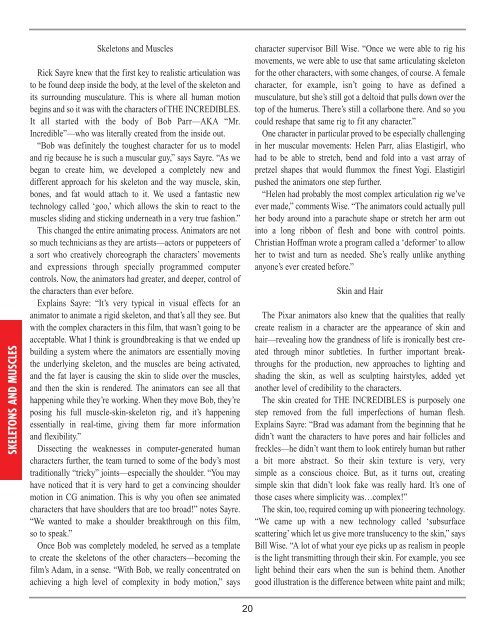Incredible - The Entertainment Magazine
Incredible - The Entertainment Magazine
Incredible - The Entertainment Magazine
You also want an ePaper? Increase the reach of your titles
YUMPU automatically turns print PDFs into web optimized ePapers that Google loves.
SKELETONS AND MUSCLES<br />
Skeletons and Muscles<br />
Rick Sayre knew that the first key to realistic articulation was<br />
to be found deep inside the body, at the level of the skeleton and<br />
its surrounding musculature. This is where all human motion<br />
begins and so it was with the characters of THE INCREDIBLES.<br />
It all started with the body of Bob Parr—AKA “Mr.<br />
<strong>Incredible</strong>”—who was literally created from the inside out.<br />
“Bob was definitely the toughest character for us to model<br />
and rig because he is such a muscular guy,” says Sayre. “As we<br />
began to create him, we developed a completely new and<br />
different approach for his skeleton and the way muscle, skin,<br />
bones, and fat would attach to it. We used a fantastic new<br />
technology called ‘goo,’ which allows the skin to react to the<br />
muscles sliding and sticking underneath in a very true fashion.”<br />
This changed the entire animating process. Animators are not<br />
so much technicians as they are artists—actors or puppeteers of<br />
a sort who creatively choreograph the characters’ movements<br />
and expressions through specially programmed computer<br />
controls. Now, the animators had greater, and deeper, control of<br />
the characters than ever before.<br />
Explains Sayre: “It’s very typical in visual effects for an<br />
animator to animate a rigid skeleton, and that’s all they see. But<br />
with the complex characters in this film, that wasn’t going to be<br />
acceptable. What I think is groundbreaking is that we ended up<br />
building a system where the animators are essentially moving<br />
the underlying skeleton, and the muscles are being activated,<br />
and the fat layer is causing the skin to slide over the muscles,<br />
and then the skin is rendered. <strong>The</strong> animators can see all that<br />
happening while they’re working. When they move Bob, they’re<br />
posing his full muscle-skin-skeleton rig, and it’s happening<br />
essentially in real-time, giving them far more information<br />
and flexibility.”<br />
Dissecting the weaknesses in computer-generated human<br />
characters further, the team turned to some of the body’s most<br />
traditionally “tricky” joints—especially the shoulder. “You may<br />
have noticed that it is very hard to get a convincing shoulder<br />
motion in CG animation. This is why you often see animated<br />
characters that have shoulders that are too broad!” notes Sayre.<br />
“We wanted to make a shoulder breakthrough on this film,<br />
so to speak.”<br />
Once Bob was completely modeled, he served as a template<br />
to create the skeletons of the other characters—becoming the<br />
film’s Adam, in a sense. “With Bob, we really concentrated on<br />
achieving a high level of complexity in body motion,” says<br />
20<br />
character supervisor Bill Wise. “Once we were able to rig his<br />
movements, we were able to use that same articulating skeleton<br />
for the other characters, with some changes, of course. A female<br />
character, for example, isn’t going to have as defined a<br />
musculature, but she’s still got a deltoid that pulls down over the<br />
top of the humerus. <strong>The</strong>re’s still a collarbone there. And so you<br />
could reshape that same rig to fit any character.”<br />
One character in particular proved to be especially challenging<br />
in her muscular movements: Helen Parr, alias Elastigirl, who<br />
had to be able to stretch, bend and fold into a vast array of<br />
pretzel shapes that would flummox the finest Yogi. Elastigirl<br />
pushed the animators one step further.<br />
“Helen had probably the most complex articulation rig we’ve<br />
ever made,” comments Wise. “<strong>The</strong> animators could actually pull<br />
her body around into a parachute shape or stretch her arm out<br />
into a long ribbon of flesh and bone with control points.<br />
Christian Hoffman wrote a program called a ‘deformer’ to allow<br />
her to twist and turn as needed. She’s really unlike anything<br />
anyone’s ever created before.”<br />
Skin and Hair<br />
<strong>The</strong> Pixar animators also knew that the qualities that really<br />
create realism in a character are the appearance of skin and<br />
hair—revealing how the grandness of life is ironically best created<br />
through minor subtleties. In further important breakthroughs<br />
for the production, new approaches to lighting and<br />
shading the skin, as well as sculpting hairstyles, added yet<br />
another level of credibility to the characters.<br />
<strong>The</strong> skin created for THE INCREDIBLES is purposely one<br />
step removed from the full imperfections of human flesh.<br />
Explains Sayre: “Brad was adamant from the beginning that he<br />
didn’t want the characters to have pores and hair follicles and<br />
freckles—he didn’t want them to look entirely human but rather<br />
a bit more abstract. So their skin texture is very, very<br />
simple as a conscious choice. But, as it turns out, creating<br />
simple skin that didn’t look fake was really hard. It’s one of<br />
those cases where simplicity was…complex!”<br />
<strong>The</strong> skin, too, required coming up with pioneering technology.<br />
“We came up with a new technology called ‘subsurface<br />
scattering’ which let us give more translucency to the skin,” says<br />
Bill Wise. “A lot of what your eye picks up as realism in people<br />
is the light transmitting through their skin. For example, you see<br />
light behind their ears when the sun is behind them. Another<br />
good illustration is the difference between white paint and milk;


